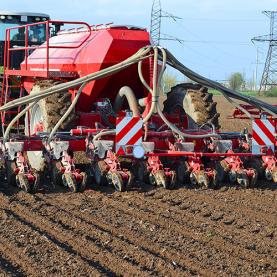Integrated farming and sustainable farming
Midway between intensive farming and organic farming, integrated farming and sustainable farming first appeared after the Second World War. Integrated farming aims to reduce the use of chemicals by favouring preventive cultivation methods and biological pest control. Sustainable farming is less radical and allows the use of chemicals according to tolerance threshold of crops.
The quest for eco-friendly and healthy food production
Environmental imbalances (water pollution, soil erosion, loss of biodiversity, etc.) and the health risks caused by intensive pesticide use after the Second World War led farmers to question the systematic use of synthetic chemical inputs. In the 1950s, entomologists working on biological pest control developed the concept of integrated pest control. This combines the use of chemical treatments with biological treatments in order to limit the economic costs and ecological damage caused by large quantities of chemical inputs. The International Organization for Biological Control (IOBC), founded in 1955, developed the concept of integrated protection. It promotes preventive methods of cultivation in order to limit the amount of pesticides required. Integrated protection offers a range of cultivation methods that deter pests (selecting plants that are more resistant, rotation and distribution of crops, mechanical weeding, irrigation, etc.), while meeting farms’ socio-economic, ecological and toxicological requirements.
In the late 1970s, the IOBC extended integrated protection to include integrated farming. It considers the farming system as a whole, and takes into account all the production factors to achieve long-term viability. However, different interpretations and regulations mean that the implementation of integrated farming methods varies enormously from country to country. In Europe, for example, some countries favour integrated agriculture as a whole (Austria, Portugal), while others focus on certain practices, whether crop rotation in France or, in Denmark, the establishment of buffer zones to limit water contamination by pesticides.
Sustainable farming, which claims to be more environmentally friendly and economically viable, is often confused with integrated farming. However, unlike the integrated approach, sustainable farming does not promote the exclusive use of biological cultivation and pest control methods, but allows the use of chemical inputs according to the tolerance threshold of crops. The concept of sustainable farming first appeared in France in the 1990s, as part of an initiative by FARRE, an association of phytosanitary product manufacturers as well as agriculture organisations and trade unions, before spreading to other European countries (Luxembourg, Sweden, Hungary, the United Kingdom and the Netherlands).
ANGELUCCI, Marie-Alix, MUNDLER, Patrick, 2007. La qualification au titre de l’agriculture raisonnée : limites et enjeux des études prospectives. Courrier de l’environnement de l’INRA. Septembre 2007 n° 54, pp. 19-31.
BAGGIOLINI, Mario, 1990. Production Intégrée en Suisse : I. aperçu historique de la "production agricole intégrée". Bulletin de la Société Entomologique Suisse. 1990. n°63, pp. 493-500. http://doi.org/10.5169/seals-402422
BERNARD DE RAYMOND, Antoine, 2011. L’Agriculture Raisonnée, un échec ? La concurrence entre normes environnementales sur le marché des fruits et légumes. In : Normaliser au nom du développement durable, Versailles, Quae, 2012, pp. 65-82.
BIRKMIRE, Alexandra, 2013. Guide des pratiques européennes de production intégrée [en ligne]. AREFLH І Assemblée des Régions Européennes Fruitières, Légumières et Horticoles. [Consulté le 16 mars 2017]. Disponible à l’adresse : http://www.areflh.org/images/stories/PDF/Dossiers/Protection_des_plantes/Production_integree/Production_int%C3%A9gr%C3%A9e_2013_FINAL_FR.pdf
FARRE І Forum des Agriculteurs Responsables Respectueux de l'Environnement, Date ?. 10 Questions-réponses. [en ligne]. [Consulté le 16 mars 2017]. Disponible à l’adresse : http://www.farre.org/index.php?id=93
FERRON, Pierre, 1999. Protection intégrée des cultures : évolution du concept et de son application. Cahiers Agricultures. 1999. n°8, pp. 389-396 [en ligne]. [Consulté le 16 mars 2017]. Disponible à l’adresse : https://www7.inra.fr/dpenv/ferpid19.htm
HOULLIER, François, 2007. La recherche en protection intégrée des cultures à l'INRA. Défis d’une approche systémique : modéliser, expérimenter, innover, évaluer, collaborer. Innovations agronomiques. 2007, n°1, pp. 3-14.
LEFEBVRE, Marianne, LANGRELL, Stephen, GOMEZ-Y-PALOMA, Sergio, 2013. Lutte intégrée : une nouvelle norme pour l'agriculture européenne?. In : 19èmes Controverses européennes de Marciac. [en ligne]. Marciac, France. 30-31 Juillet 2013. pp. 1-2. [Consulté le 16 mars 2017]. Disponible à l’adresse : http://www.agrobiosciences.org/img/pdf/contribution_Marianne_Lefebvre_Marciac.pdf
LUCAS, Philippe, 2007. Le concept de la protection intégrée des cultures. Innovations Agronomiques. 2007. n°1, pp. 15-21.
MABY, Jacques, 2002. Agriculture raisonnée : raisons d'espace, raisons d'acteurs [en ligne]. [Consulté le 16 mars 2017]. Disponible à l’adresse : http://www.univ-avignon.fr/fileadmin/documents/Users/Fiches_X_P/Agriculture_raisonnee__raisons_d_espace__raisons_d_acteurs.pdf
POULAIN, Cécile, 2014. La protection intégrée sous toutes les cultures. INRA І Institut National de Recherche Agronomique [en ligne]. 6 février 2014. [Consulté le 16 mars 2017]. Disponible à l’adresse : http://www.inra.fr/Grand-public/Agriculture-durable/Tous-les-dossiers/Dependance-aux-pesticides
PERVANCHON, Frank, BLOUET, André, NGUYEN, Geneviève, SARTHOU, Jean-Pierre, FÉRET, Samuel, 2002. Lexique des qualificatifs de l'agriculture [en ligne]. Courrier de l'environnement de l'INRA. Février 2002. n°45. pp. 117-136. [Consulté le 16 mars 2017]. Disponible à l’adresse : https://hal.archives-ouvertes.fr/hal-01202642/file/C45Blouet.pdf








